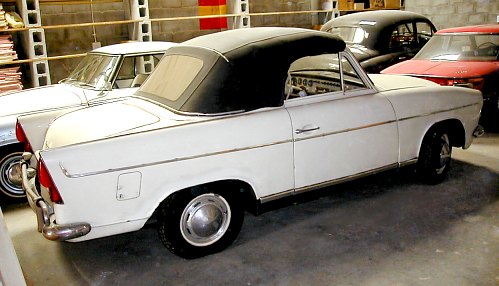Description
The Hansa 1100 Cabriolet was the open-top counterpart to the elegant Hansa 1100 Coupé, produced by the Borgward Group during the mid-1950s. It represented one of the most refined and desirable small cars in postwar Germany, blending practicality with graceful styling and the leisurely pleasure of open-air motoring. For a brief moment, it symbolized the optimism of a country rebuilding its automotive industry—offering drivers not just mobility, but also a sense of style and freedom.
The design of the Hansa 1100 Cabriolet followed the same smooth and rounded aesthetic as the coupé and saloon versions, but the absence of a fixed roof lent it a lighter, more elegant look. The proportions were well balanced, with a long bonnet, gently curving fenders, and a short rear deck. The soft folding fabric roof was neatly integrated into the body design, maintaining clean lines whether raised or lowered. Chrome accents on the grille, bumpers, and window surrounds added a touch of sophistication, while the overall form was understated yet distinctly stylish. In the context of 1950s Germany—where most small cars were utilitarian—the Hansa 1100 Cabriolet stood out as something truly special.
Inside, the car provided seating for four, though the rear seats were best suited to shorter journeys. The interior was simple but well appointed, featuring a symmetrical dashboard with clear instrumentation and tasteful detailing. The seats were upholstered in quality materials, and the cabin trim reflected Borgward’s reputation for good craftsmanship. With the roof folded back, the interior felt open and inviting, offering the pure charm of classic cabriolet motoring.
Under the bonnet, the Hansa 1100 Cabriolet shared its mechanicals with the other Hansa 1100 models. It was powered by an 1,097 cc inline four-cylinder engine producing around 40 horsepower, paired with a four-speed manual gearbox. This combination allowed for a top speed of roughly 120 km/h (75 mph), perfectly adequate for relaxed touring or city driving. The car’s modest weight and well-tuned chassis made it easy to handle, while the smooth, flexible engine provided a steady and refined performance.
Driving the Hansa 1100 Cabriolet was an experience defined less by outright speed and more by balance and poise. The suspension was comfortable, soaking up uneven roads, and the steering light and predictable. The open roof transformed even an ordinary drive into an occasion—ideal for summer motoring along country roads or coastal routes. For many owners, the car offered the sophistication of a luxury touring car at a far more attainable price.
Production numbers of the Hansa 1100 Cabriolet were relatively low compared to the sedan versions. Building convertibles required more craftsmanship and time, and such cars were always niche purchases in postwar Europe. As a result, few were made, and even fewer have survived, making the model a rarity today.
The Hansa 1100 Cabriolet is now regarded as one of the most charming and collectible examples of Borgward’s work under the Hansa marque. Its combination of elegant Frua-inspired lines, reliable engineering, and open-top appeal captures the spirit of 1950s European motoring—a time when even small cars could aspire to grace and individuality. Beautifully proportioned and technically competent, it remains a reminder of a period when optimism, style, and ingenuity defined the rebirth of the German car industry.
